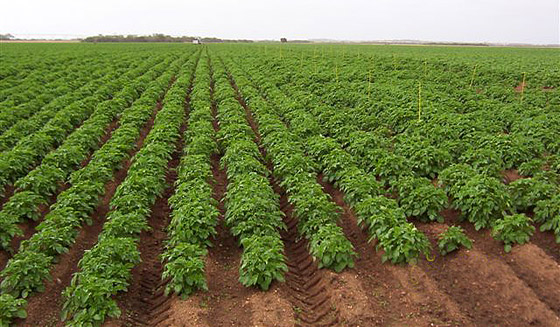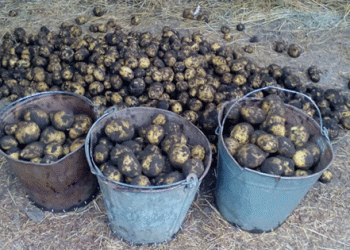In an interview with Paweł Kaczmarek, a board member of Top Farms Wielkopolska, we talked about important aspects of the cultivation of french potato and chips and how important soil is in agricultural production.
Top Farms Group is the undisputed leader in the production of potato chips and chips. Potatoes for crisps and chips are grown in Wielkopolska and Głubczyce in Opole, on an area of 2600 hectares. The company additionally has 200 hectares of seed potato plantations in the vicinity of Olsztyn near Kętrzyn. However, the strength of Top Farms is not only potato cultivation, but also other plant species. Top Farms focuses primarily on innovation and a holistic approach to agriculture. Agriculture is a great responsibility for both the customer and the planet, and in particular the care of the soil. The challenges of the Green Deal have long existed in the way top farms are run. What does it look like to grow a potato chips and chips? What good agricultural practices can we implement today?
AW: What is the difference between growing a french fries potato and a crisp potato and other directions of use?
PK In fact, the differences are small and are mainly due to the needs of processors. In the cultivation of french potato, the characteristic desired by the processor is their length, so that the customer and finally the consumer are satisfied with the length of the fries. In the case of chips, however, we focus primarily on its parameters. In this case, too long potatoes are not desirable. Potatoes for crisps should have a good alignment in the 40-90 mm segment. Those over 9 cm are not taken into account by processors, otherwise it is the case with french fries potatoes. Although the difference in the cultivation of chips and chips may seem small compared to edible potatoes, it is very much reflected in the technology of cultivation. The key in growing potatoes for chips and chips is the depth of planting, from which the number of fried tubers results. Further distance in planting, which affects how many tubers are able to maintain a given bush. And the size of potatoes is strongly dependent on the number of tubers tied under the bush.
Is the cultivation of chips and chips for everyone? What conditions does the farm have to meet to implement potato growing technology in these directions?
Unfortunately, not every farm can implement these technologies. There are several so-called barriers to entry and conditions to be able to grow potatoes for chips or chips. When comparing potato cultivation to other cultivated species, we should take into account the fact that potatoes require soils with regulated water-air relations. Ideally, the farm should have flat, aligned and permeable fields. Potato is a crop that is sensitive to water stagnant, especially when it lasts too long. Therefore, potato-growing stations should not be hilly or tilted, where there is a washing phenomenon. Another barrier is large initial capital. Growing a potato, especially at the beginning, requires some investment. The purchase of an irrigation system and planting and harvesting machines requires considerable cash. A relatively high cost is also seed seed, which is about 4000 PLN per hectare. On the other hand, in the very 19th century, the hydration system plays a very important role in the food and chips potato itself, which is tasked with covering the water demand in each phase of potato development. Water scarcity affects not only the volume of yields, but also their quality. It is worth knowing that water scarcity can cause the occurrence of the phenomenon of child’s behavior, which in the technology of growing chips and chips potatoes is especially undesirable. It contributes to the formation of second increments, and these affect the variable quality of the part of the tuber which grows and the original one. As a result, the primary and growing parts do not mature evenly, which in turn makes the chips different in color, which is not desirable by consumers. Consumers expect crisps of uniform color and shade, discoloration is not welcome. Crop rotation is also very important. In our farm, a potato in a crop rotation appears once every 4 years. Farms with a smaller arena will automatically grow less potato. On such farms, it will be difficult to repay the investments made and to obtain the profitability of production. Top Farms meets farmers who would like to grow potatoes in french fries or chips technology, have farms near the company’s fields, and have flat, aligned and permeable fields and irrigation infrastructure. We are happy to cooperate with farmers on a contracting basis. We offer our colleagues technology, seed, as well as services such as planting, forming redlines or excavations. We have been practicing this type of cooperation for several years now and have been successfully developing it. In fact, a few percent of total potato production is made up of cooperation with smaller farms.
The farmer gets access to knowledge, innovation and can grow a new variety in crop rotation. What are the other benefits of working with you?
In our farm we focus on proper crop rotation. In fact, we plan it well in advance. Working with external farms already 2 years earlier we start preparing for potato production. We start with the pre-crop. We avoid planting potatoes after rapeseed or grain corn. Cereals are the desired pre-harvest for us. However, it is extremely important that they are weeded in a specific way, excluding active substances harmful both to the soil and to the potato itself. We avoid the use of herbicides containing certain active substances from sulfonylureas, because these long-term persist in the soil and their residues may be present in the potato. On our farm we are guided by the Biological Production Standard, which is responsible for both soil protection, as well as the quality and safety of products supplied to our customers and, consequently, to consumers. Another important issue for us is to leave straw after harvesting cereals, which we carefully work out. Unfortunately, the drawback of growing a potato is that it has a limiting effect on caries. A number of treatments, from cultivation to planting to harvesting, aeration of the soil to a large extent, and this in turn affects the burning of organic matter. We want to protect the soil from the loss of organic matter, hence, firstly, the remains of the fertilizer, and then the manure. It is important for us that it is cattle manure, and in its absence we use another organic fertilizer. This is so important that natural fertilizers help in the distribution of straw, are an excellent microbial medium, and are also a source of nutrients for burns. Burnt is the next step in our technology. There are several arguments in favour of sowing them. Firstly, they are excellent indicator plants, especially in fields whose history we are not familiar with. Thanks to them, we can find out what herbicides were used and whether they will be safe for the potato. Burnt soil, which prevents excessive transpiration of water. They prevent erosion and also bind components from deeper soil fractions, and as a result of decomposition are made available to follow-up plants. Thanks to this, we build fertilizer potential. Soil-improving practices are extremely important to us. Farmers working with us can learn from us these practices, thereby taking care of the soil on their farms.
What is the market for chips and chips potato? What are the consumer trends?
Consumer trend predictions indicate that consumption of crisps will decrease. However, the pandemic of coronavirus shows quite the opposite direction. Consumption of salty snacks has increased, although such products do not associate positively. Nevertheless, it should be remembered that we produce not only for the domestic market, but also for other countries. Poland is a country that has very good conditions for growing potatoes, which is why the area of this crop is increasing in the chips direction. The market for french fries potatoes is also growing steadily. We are increasingly busy, we live faster and faster, which also means that we are looking for easy ways to prepare meals. We are also increasingly willing to eat outside the house. So far, due to The Covid-19, gastronomy activity is limited, but it is expected that after the pandemic, the market share of this market will increase.
Have you developed biology, code 5C? What’s that?
Top Farms Biological Production Standard, or Top Farms Biology, is based on five points – five C in English: calcium, carbon, cover crops, cultivation and culture. C – like Calcium, or lime. We believe that lime is one of the most important elements in the soil. It is responsible not only for the regulation of the soil reaction, but also is part of soil colloids, affects the development of positive microflora and is a nutrient element for plants. In turn, coal, the content of which tells us about soil productivity. At Top Farms, we emphasize proper crop rotation and limit the export of organic matter from the soil. Further burned, the values of which I mentioned earlier. In addition, we focus on proper soil cultivation, as well as the culture of running a farm. We build retention tanks, which are a source of water for irrigation of potatoes during periods of drought. We also assume the benefit of bees to protect pollinators. We focus on a holistic approach to production.
Where can the consumer get potatoes from Top Farm crops?
Top Farms isn’t just about potatoes. Nevertheless, our potatoes go to the largest companies that have french fries in their assortment, both in restaurant chains, including the most famous and popular fast food chains, as well as those for preparation in homes. Our potatoes reach both the recipients Polish and the Baltic Sea basin. There is a high probability that the chips you are consuming are made from our potatoes. On our farm we produce a specific type of wheat, so-called flour cookie, which can be found in most cookies and wafers of leading domestic and international producers. We are the largest producer of spies, which is a wheat of high value to man. In recent years, we have focused on the health-promoting crops of rye, flax or oats. We are the first producer of sweet potatoes in the country. We also grow purple corn. We try to respond to the needs of consumers, which is why we also have bio-crops. We share our experiences and innovations with the farms working with us, so they have a chance to improve the fertility of their soils and get acquainted with innovations.
Author: Dr. Inż. Aleksandra Wieremczuk
source: agroprofil.pl









